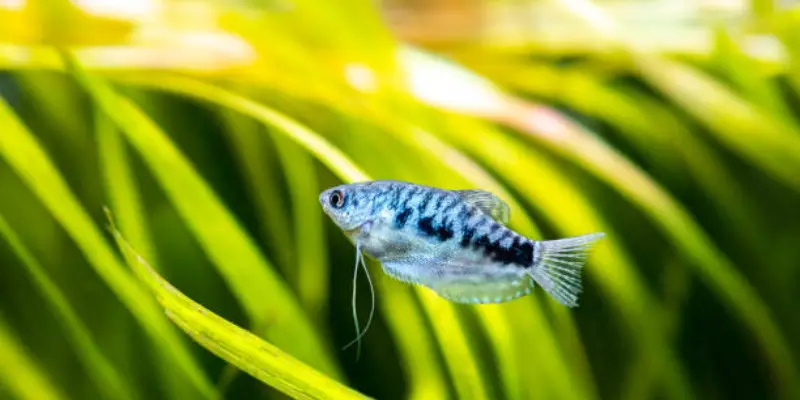This is a question we get asked often and there are several possible reasons for this color change.
Loss of Appetite
If your Blue Gourami appears to be losing his appetite for food, there may be something off with the water in their tank. The first thing you should do if your fish stops eating is check the water quality. Use an API Freshwater Test Kit to get accurate results on your water parameters.
If the tank’s ammonia levels are high, you should perform a large water change and check them again the next day. If this does not fix the loss of appetite, try treating the fish with Kanamycin.
This medication comes in many different forms depending on your tank size.
- Kanacyn – Treats 40 Gallons or Less
- Kanamycin Sulfate – Treats 160 Gallons
If neither of these options works, you should check the pH levels in the tank to ensure they are between 7.8 and 8.5. Use an API pH Test Kit to get accurate results on your water parameters.
If the pH levels are off, you may need to purchase a buffer to fix the issue. This will raise or lower the overall pH levels in your tank. Buffers can be purchased at any local fish store for around five dollars.
Fin Rot
Another common cause of black spots appearing on blue gourami is known as Fin Rot. This occurs when the fins on your fish start to deteriorate or fall apart.
The best method to stop Fin Rot is by treating it before it gets out of hand. Use an API Fungus Cure treatment in your tank if you notice any signs of this disease, which include:
- Fin rot (white and red fraying on the fins)
- Fins appear to be eaten away at the base
- The edges of your fish’s fins may also look ragged and worn down
Treating this disease early is crucial because once it has set in, it can be very difficult to get rid of. If you wait too long, the rotting fins will only spread further and make it harder for your fish to swim.
If you are noticing fin rot, use an API Fungus Cure treatment in your tank right away. This medication comes in the form of a bottle containing powdered medicine and instructions on how much to add per gallon and how often to dose the tank.
To treat the tank, remove all your live plants first to prevent them from being damaged by the medication. Turn off any filtration you have running and wait 24 hours after adding the treatment before you turn it back on again.
If the black dots on your fish’s body do not go away within five days of adding a Fungus Cure treatment, you should check your water parameters to ensure they are within the proper levels.
An improper pH level can cause Fin Rot due to the fish’s constant exposure to stress and illness. Use an API Freshwater Master Test Kit if you want accurate results on your tank’s pH levels.
If the black dots on your fish do not disappear after treating for Fin Rot, you should check your water parameters to ensure they are within the proper levels.
An improper pH level can cause Fin Rot due to the fish’s constant exposure to stress and illness. Use an API Freshwater Master Test Kit if you want accurate results on your tank’s pH levels.
If none of these issues seem to be causing your fish to lose his appetite or develop black dots on his body, you should quarantine him and slowly change out about 30% of the water in the tank every day for five days.
If your fish appears completely healthy during this process, it’s possible that he simply has an infection that is not related to any other problems in the tank. You should continue this water change for a few more days to ensure that the infection does not spread.
Fish Tuberculosis
Last but not least, your blue gourami may have developed Fish Tuberculosis, which is caused by Mycobacterium marinum. This bacterium lives anywhere from 20 – 30 days outside of a fish’s body and can cause serious problems if not treated quickly.
Fish Tuberculosis is the third most common infection found in aquarium fish, making it important to diagnose and treat any gouramis you have with black spots immediately.
If your fish has this disease, you will notice that his appetite suddenly decreases drastically. The blue spots on his body will darken, and the areas around them may swell. You’ll also see that your fish’s intestines are protruding towards the outside of his body through holes in the scales.
When you notice any of these symptoms, act fast to prevent further complications. Use an API Fungus Cure treatment if you suspect that your fish has developed Fish Tuberculosis and add aquarium salt to your tank if he already has it.
A combination of kanamycin sulfate and niddamycin, both of which are antibiotics, is the most effective treatment for this disease. However, many pet stores do not carry these medications because they require a prescription from a veterinarian.
If you can’t find kanamycin sulfate or niddamycin at your local store, you should quarantine your fish and treat him for three days with an antibiotic made from a different type of nitroimidazole.
You will have to continue the treatment until all the scales on your fish’s body begin to look normal again and he regains his appetite. It’s likely that your fish will still have some damage to his intestines even after the scales look normal so you should be very careful when feeding him during this time.
The most common causes of fish tuberculosis are long-term exposure to poor water conditions and a lack of proper nutrition. You can prevent your fish from developing this disease by making sure he always has clean, warm water and a nutritious diet.
If you notice that the black spots on your gourami’s body have been getting larger or if he seems to be losing his appetite, you should quarantine him and treat him for possible tuberculosis.
Don’t ignore these symptoms because your fish cannot live very long with this disease even if it is treated. Most fish die within 25 days of contracting the bacterium that causes Tuberculosis, so act fast!
I hope this article was helpful. Please remember that I am not a veterinarian and I do not have the professional knowledge required to diagnose diseases in fish. This article is based on my experience, research, and expertise as an aquarium hobbyist. If your fish has black spots on its body, please take it to an aquarium specialist for a more accurate diagnosis.
If you have any questions or comments about this article, please leave a comment below or send me an email using the Contact page.

